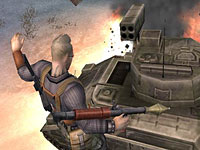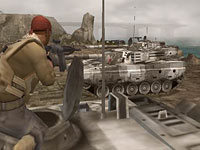Hello, and welcome to my designer diary. First, I'd like to point out that I'm not a designer. I'm a producer. We're a different breed of developer than the designer, although we live in the same habitat. Now, I'm sure all you hardcore gamers know what I do, but just to fill in the two non-gamers who will read this article (my mom and dad), a producer has a huge range of duties, which keeps us in the office about 23 hours a day. We're in charge of putting a team together, managing the task schedule, providing everyone with equipment, and making sure a AAA quality product eventually finds its way to the shelf. I spend my day talking to the publisher, coordinating the delivery of assets between the artists and programmers, and trouble-shooting the daily life-and-death situations.
Much of my day is spent just talking to the team. We have a truly international staff: Swedes, Russians, Canadians, Chinese, South Koreans, Australians, and even a few Wisconsinites. You'll be hearing from many of the other developers on the team in later designer diaries, including words from actual game designers. In the lot, there are vehicle artists, mission scripters, A.I. programmers, and even a few animators. Of all the teams with which I've worked, this one is the best.
Mercenaries is a unique product and it's hard for me to describe the experience on paper. Trust me, as beautiful as the screenshots are, you won't experience the gameplay from the screenshots. You won't experience the tight controls from the movies. You have to sit down and actually play the game to understand the Mercenaries experience. To many who have played the game, the seamlessness of the mechanics suggest everything was all in place from the start. In fact, there are people who see the game and think everything onscreen was planned from day one and the whole process from the start was easy. Not true. We've worked through some difficult challenges in order to push the Xbox about as far as it can go.
I believe much of this innovation stems from a simple motto our director proclaimed during the design phase -- "If you can see it, you can use it/drive it/destroy it!" -- tall orders to demand from a video game. That meant if you took down an enemy who possessed a cool weapon, you should expect to be able to pick up that weapon and use it for yourself. Or if you saw an enemy driving a tank, you'd expect to be able to drive that tank yourself. Or, if you came to a bridge and had explosives in your inventory, you'd expect to be able to blow it up.
In fact, you are running loose on a playground of destruction and have the ability to destroy every building and every object in the world with reckless abandon. To many, this is hours of fun in and of itself. However, as we dug deeper into this as the core of the game, we began to realize that there was a story that sold a much stronger fantasy than just being able to "blow stuff up."







